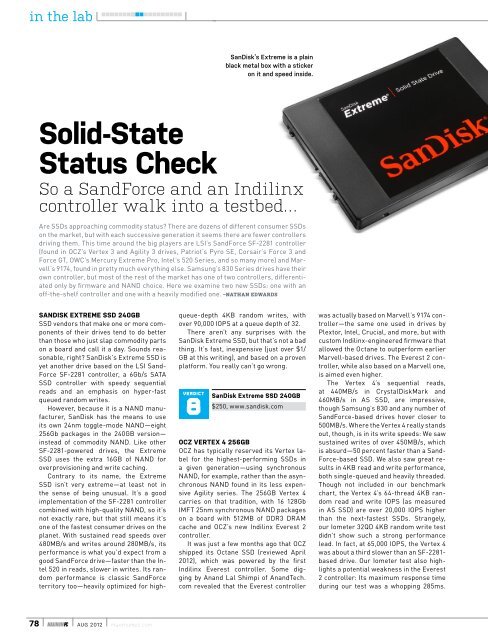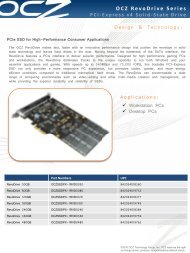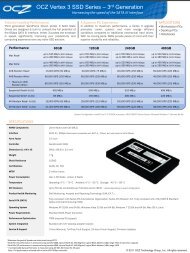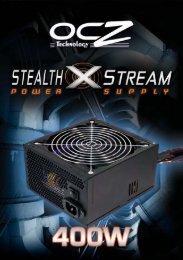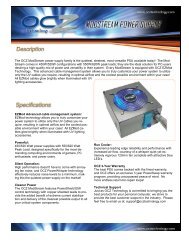Solid-State Status Check - OCZ
Solid-State Status Check - OCZ
Solid-State Status Check - OCZ
Create successful ePaper yourself
Turn your PDF publications into a flip-book with our unique Google optimized e-Paper software.
in the lab<br />
SanDisk’s Extreme is a plain<br />
black metal box with a sticker<br />
on it and speed inside.<br />
<strong>Solid</strong>-<strong>State</strong><br />
<strong>Status</strong> <strong>Check</strong><br />
So a SandForce and an Indilinx<br />
controller walk into a testbed…<br />
Are SSDs approaching commodity status? There are dozens of different consumer SSDs<br />
on the market, but with each successive generation it seems there are fewer controllers<br />
driving them. This time around the big players are LSI’s SandForce SF-2281 controller<br />
(found in <strong>OCZ</strong>’s Vertex 3 and Agility 3 drives, Patriot’s Pyro SE, Corsair’s Force 3 and<br />
Force GT, OWC’s Mercury Extreme Pro, Intel’s 520 Series, and so many more) and Marvell’s<br />
9174, found in pretty much everything else. Samsung’s 830 Series drives have their<br />
own controller, but most of the rest of the market has one of two controllers, differentiated<br />
only by firmware and NAND choice. Here we examine two new SSDs: one with an<br />
off-the-shelf controller and one with a heavily modified one. –Nathan Edwards<br />
SanDisk Extreme SSD 240GB<br />
SSD vendors that make one or more components<br />
of their drives tend to do better<br />
than those who just slap commodity parts<br />
on a board and call it a day. Sounds reasonable,<br />
right? SanDisk’s Extreme SSD is<br />
yet another drive based on the LSI Sand-<br />
Force SF-2281 controller, a 6Gb/s SATA<br />
SSD controller with speedy sequential<br />
reads and an emphasis on hyper-fast<br />
queued random writes.<br />
However, because it is a NAND manufacturer,<br />
SanDisk has the means to use<br />
its own 24nm toggle-mode NAND—eight<br />
256Gb packages in the 240GB version—<br />
instead of commodity NAND. Like other<br />
SF-2281-powered drives, the Extreme<br />
SSD uses the extra 16GB of NAND for<br />
overprovisioning and write caching.<br />
Contrary to its name, the Extreme<br />
SSD isn’t very extreme—at least not in<br />
the sense of being unusual. It’s a good<br />
implementation of the SF-2281 controller<br />
combined with high-quality NAND, so it’s<br />
not exactly rare, but that still means it’s<br />
one of the fastest consumer drives on the<br />
planet. With sustained read speeds over<br />
480MB/s and writes around 280MB/s, its<br />
performance is what you’d expect from a<br />
good SandForce drive—faster than the Intel<br />
520 in reads, slower in writes. Its random<br />
performance is classic SandForce<br />
territory too—heavily optimized for highqueue-depth<br />
4KB random writes, with<br />
over 90,000 IOPS at a queue depth of 32.<br />
There aren’t any surprises with the<br />
SanDisk Extreme SSD, but that’s not a bad<br />
thing. It’s fast, inexpensive (just over $1/<br />
GB at this writing), and based on a proven<br />
platform. You really can’t go wrong.<br />
verdict<br />
8<br />
SanDisk Extreme SSD 240GB<br />
$250, www.sandisk.com<br />
<strong>OCZ</strong> Vertex 4 256GB<br />
<strong>OCZ</strong> has typically reserved its Vertex label<br />
for the highest-performing SSDs in<br />
a given generation—using synchronous<br />
NAND, for example, rather than the asynchronous<br />
NAND found in its less expensive<br />
Agility series. The 256GB Vertex 4<br />
carries on that tradition, with 16 128Gb<br />
IMFT 25nm synchronous NAND packages<br />
on a board with 512MB of DDR3 DRAM<br />
cache and <strong>OCZ</strong>’s new Indilinx Everest 2<br />
controller.<br />
It was just a few months ago that <strong>OCZ</strong><br />
shipped its Octane SSD (reviewed April<br />
2012), which was powered by the first<br />
Indilinx Everest controller. Some digging<br />
by Anand Lal Shimpi of AnandTech.<br />
com revealed that the Everest controller<br />
was actually based on Marvell’s 9174 controller—the<br />
same one used in drives by<br />
Plextor, Intel, Crucial, and more, but with<br />
custom Indilinx-engineered firmware that<br />
allowed the Octane to outperform earlier<br />
Marvell-based drives. The Everest 2 controller,<br />
while also based on a Marvell one,<br />
is aimed even higher.<br />
The Vertex 4’s sequential reads,<br />
at 440MB/s in CrystalDiskMark and<br />
460MB/s in AS SSD, are impressive,<br />
though Samsung’s 830 and any number of<br />
SandForce-based drives hover closer to<br />
500MB/s. Where the Vertex 4 really stands<br />
out, though, is in its write speeds: We saw<br />
sustained writes of over 450MB/s, which<br />
is absurd—50 percent faster than a Sand-<br />
Force-based SSD. We also saw great results<br />
in 4KB read and write performance,<br />
both single-queued and heavily threaded.<br />
Though not included in our benchmark<br />
chart, the Vertex 4’s 64-thread 4KB random<br />
read and write IOPS (as measured<br />
in AS SSD) are over 20,000 IOPS higher<br />
than the next-fastest SSDs. Strangely,<br />
our Iometer 32QD 4KB random write test<br />
didn’t show such a strong performance<br />
lead. In fact, at 65,000 IOPS, the Vertex 4<br />
was about a third slower than an SF-2281-<br />
based drive. Our Iometer test also highlights<br />
a potential weakness in the Everest<br />
2 controller: Its maximum response time<br />
during our test was a whopping 285ms.<br />
78 MAXIMUMPC AUG 2012 maximumpc.com
The Everest 2 controller in the<br />
Vertex 4 is a modified Marvell<br />
controller with custom Indilinx<br />
firmware.<br />
benchmarkS<br />
SanDisk<br />
Extreme<br />
SSD<br />
<strong>OCZ</strong> Vertex 4<br />
Patriot Pyro<br />
SE<br />
<strong>OCZ</strong><br />
Octane<br />
Samsung<br />
830 Series<br />
SSD<br />
Capacity 240GB 256GB 240GB 512GB 256GB<br />
That’s about eight times the lag we’d see<br />
from a SandForce-powered drive, though<br />
only about half the 429ms maximum response<br />
time on <strong>OCZ</strong>’s Octane drive. Other<br />
SSDs based on Marvell controller architecture<br />
also have maximum lag times in<br />
the 100ms to 500ms range.<br />
Its blazing-fast write performance<br />
meant that the Vertex 4 edged out all comers<br />
in our Premiere Pro test, albeit by just<br />
a few seconds. In PCMark Vantage and<br />
7’s storage suites, the Vertex 4 doesn’t do<br />
quite as well as a SandForce drive, but the<br />
differences are minimal.<br />
With an MSRP of $350, the 256GB<br />
Vertex 4 isn’t as inexpensive as a 240GB<br />
SandForce-based SSD, but it’s already<br />
under $300 on the street, which is pushing<br />
close to the magical dollar-pergigabyte<br />
price point. Frankly we can’t<br />
believe how far SSDs have come in the<br />
past year alone.<br />
The Vertex 4’s write speeds are truly<br />
astounding, and the read speeds are nothing<br />
to scoff at, either. We’re happy to see<br />
<strong>OCZ</strong> forging its own path with the Everest<br />
2 controller. Even if it’s not, strictly<br />
speaking, new silicon, the magic firmware<br />
sauce is working here.<br />
verdict<br />
9<br />
<strong>OCZ</strong> Vertex 4 256GB<br />
$350, www.ocztechnology.com<br />
CrystalDiskMark<br />
Sustained Read (MB/s) 479.1 440.9 482 445.4 506.4<br />
Sustained Write (MB/s) 283.7 446.9 300.3 315.5 398.5<br />
AS SSD<br />
Seq. Read (MB/s) 503.8 463 506.7 432.2 502.6<br />
Seq. Write (MB/s) 278 459.3 295.2 285.9 164.1<br />
4KB Read (IOPS) 5,029 6,632 4,986 5,546 5,513<br />
4KB Write (IOPS) 15,244 17,169 14,179 10,417 12,800<br />
ATTO<br />
64KB File Read (MB/s) 490.3 396.7 443.24 408.57 405.85<br />
64KB File Write (MB/s) 441.3 470.4 487.9 287.02 515.05<br />
Iometer<br />
4KB Random Write 90,060.8 65,111.06 91,171.26 22,073.97 35,329.48<br />
Max Access Time (ms) 30 285 41 429 31<br />
Premiere Pro Encode<br />
Write (sec)<br />
PCMark Vantage x64<br />
HDD<br />
422 417 424 425 420<br />
58,366 41,568 61,686 57,030 62,168<br />
PCMark 11 x64 SST 5,282 5,171 5,305 4,945 5,257<br />
Best scores are bolded. Our current test bed is a 3.1GHz Core i3-2100 processor on an Asus P8 P67 Pro (B3 chipset) running Windows<br />
7 Professional 64-bit. All tests used onboard 6Gb/s SATA ports with latest Intel drivers.<br />
maximumpc.com AUG 2012 MAXIMUMPC<br />
79


